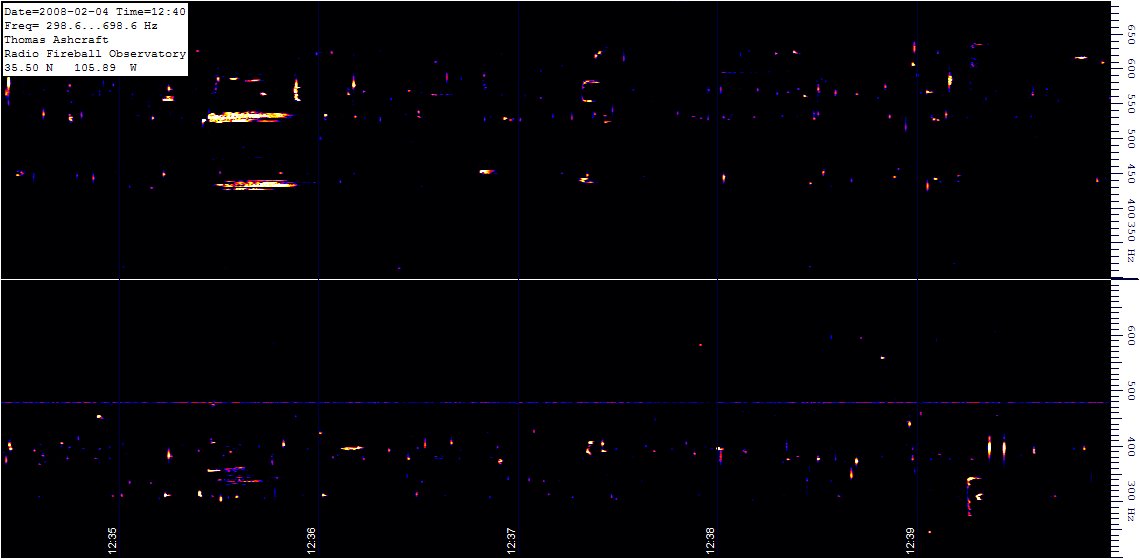
February 4, 2008 1235 UT ( 5:25 am MST )
The sky was cloudy with snow most of the night but this fireball happily passed through a thinner patch of clouds and into view.
Interesting to note that this specimen made a relatively small radio reflection compared to its size as seen on the
spectrograph above during the 1235 UT minute. There seems to be a pattern of larger
fireballs making small or even neglible forward scatter reflections.
Movie
FBsp20080204_1235ut_Ashcraft.mp4 1.6 MB 29 seconds ( full duration of forward scatter reflection )
Listen with headphones or good stereo speakers to the sonic detail if possible.
Note : Top half of spectrograph above is 61.250 MHz reception, below the white line is 83.250 MHz reception.
Thomas Ashcraft
Radio Fireball Observatory
35.50 N 105.89 W
New Mexico
:
:
:
Movies
Here are a few movies and a full archive is coming in the near future.
Note movies are primarily in .mp4 format which requires Quicktime 7.
A free Quicktime 7 player is available at: http://www.apple.com/quicktime/download/
Headphones highly recommended for fine detail of sound and doppler effects.
http://www.heliotown.com/Fireball_Sep_13_2007_Ashcraft.html
http://www.heliotown.com/Geminid_Meteors_2007_Ashcraft.html
http://www.heliotown.com/Fireball_20071129_0745ut_Ashcraft.html
http://www.heliotown.com/Fireball_Video_Oct_30_2007_Ashcraft.html
fb20071026_0755UT_Ashcraft.mp4 3.8 MB
FB20071216_1059ut_Ashcraft2.mp4 5.4 MB
fb20071214_0410ut_Ashcraft.mp4 566 KB
fb20071022_0545ut_Ashcraft.mp4 3.8MB
Method and Equipment
Briefly, here is my fireball observation and capture method as developed thus far. It is a work in progress.
VIDEO: I am visually recording the whole sky from dusk to dawn at 30 frames per second with a video camera (a HiCam HB-710E, Rainbow L163VDC4P fisheye lens ) into an iMac.
The video stream comes from the camera and passes through a Canopus ADVC110 which converts the video signal to DV and then enters the Mac via firewire.
RADIO: I am recording audio in stereo to two separate forward scatter channels using video carriers from tv channel 3 ( 61.250 MHz ) and tv channel 6 ( 83.250 MHz).
Radios are ICOM PCR-1000 operating in CW mode with separate antennas.
CHARTING: I am splitting the two forward scatter signals into SpectrumLab which serves as the audio chart recorder 24 hours a day.
METHOD: I go through the night's SpectrumLab charts and look for any prominent meteor scatter reflections and then go to that time point on the night's video capture to
check to see if there is a local fireball capture. If there is an interesting fireball I extract the movie clip from the time of the head echo to the end of the reflection.
More information on the forward scatter radio method here:
http://www.imo.net/radio
Foe access to Heliotown click button below: